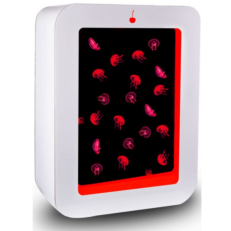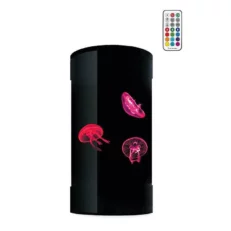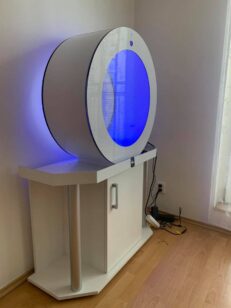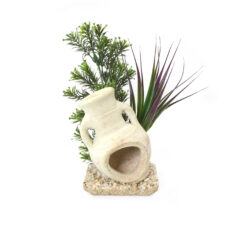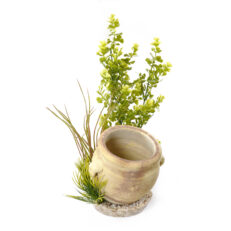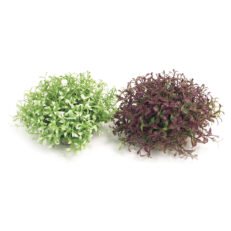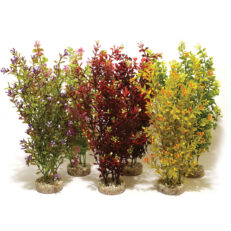
The fascination with the underwater world is a journey into a realm of enchantment and mystery, captivating the imagination of many. This article delves into the captivating world of underwater realms through the lens of both freshwater and saltwater aquariums. These aquatic ecosystems offer a unique window into a world that is both alien and mesmerizing, inviting us to explore the intricacies and beauty of aquatic life.
Freshwater aquariums represent the starting point for many in the aquarium hobby. The process of setting up a freshwater tank, from choosing the right tank size to selecting suitable fish species, is an adventure in itself. Freshwater tanks are celebrated for their accessibility, making them an ideal choice for beginners. They are generally more cost-effective and offer a wide variety of fish and plant species that can thrive in these conditions. The article will delve into common freshwater tank setups, such as community tanks, planted tanks, and species-specific environments like cichlid or goldfish tanks, exploring the unique characteristics and requirements of each.
In contrast, saltwater or marine tanks are known for their complexity and the stunning variety of marine life they can host. Setting up a saltwater tank involves careful consideration of several components, including specialized equipment, appropriate salt mix, and the incorporation of live rock or coral. The article will explore the different types of saltwater setups, including fish-only tanks, fish-only with live rock (FOWLR), and the more intricate reef tanks, each offering a unique glimpse into marine biodiversity.
Beyond the technical aspects, this article emphasizes the enchanting allure of aquariums. It focuses on how these miniature underwater worlds bring the beauty and tranquility of aquatic life into our living spaces. The therapeutic and aesthetic benefits of maintaining an aquarium are manifold, offering stress relief and the joy of crafting a personalized underwater landscape. Moreover, aquariums serve an educational purpose, particularly for children, providing a hands-on experience in understanding aquatic life and ecosystems.
An essential part of the article is the comparison between freshwater and saltwater tanks. This section examines the differences in setup and maintenance complexity, cost implications, biodiversity, and aesthetic appeal of each type. Insights are provided to guide different types of hobbyists, from beginners to experienced aquarists, in choosing the tank that best suits their interests and capabilities.
In conclusion, the article summarizes the key points discussed, highlighting the unique aspects and appeals of both freshwater and saltwater aquariums. It encourages readers to reflect on which type of tank aligns with their interests, skills, and aspirations in the world of aquaristics. The final call to action is an invitation for readers to embark on their own journey into the mesmerizing and diverse world of underwater realms, opening a door to a lifetime of fascination and learning.
Diving into Freshwater Tanks: A World of Diversity
The world of freshwater aquariums is a captivating and diverse realm, offering a unique blend of natural beauty and serene tranquility. This article seeks to transport readers into the enchanting universe of freshwater tanks, highlighting the vast diversity and aesthetic appeal they add to homes and spaces. The purpose here is to explore the intricacies of freshwater environments, showcase the popular species that thrive in them, and provide essential insights into setting up and maintaining a healthy freshwater aquarium.
Freshwater ecosystems possess distinct characteristics that define their habitats, such as specific pH levels, hardness, and temperature ranges. These environments vary greatly in nature, ranging from the dynamic flow of rivers and streams to the serene stillness of lakes and ponds. The article delves into how these diverse natural settings can be replicated in aquariums, offering a slice of nature in domestic spaces. Understanding these unique features is crucial for anyone looking to establish and maintain a thriving freshwater aquarium.
The article introduces a range of popular freshwater fish, categorizing them based on size, temperament, and care level, with examples including guppies, tetras, bettas, and cichlids. It also sheds light on the pivotal role of live plants in freshwater tanks, not only in enhancing water quality but also in providing a naturalistic habitat for fish. Popular plant choices like java fern, anubias, and hornwort are discussed. Additionally, the article offers valuable tips on creating a harmonious ecosystem that balances the needs and interactions of various fish and plant species.
A critical part of the article focuses on the equipment necessary for setting up a freshwater aquarium. It covers the essentials like filters, heaters, lighting, and substrate, explaining the purpose of each and providing guidance on selecting the right options for different tank sizes and species requirements. The importance of maintaining optimal water conditions is also emphasized, including regular testing and adjustments for various water parameters. Furthermore, the article provides a comprehensive guide on routine maintenance tasks, highlighting the significance of a consistent care regimen for the health and vitality of the aquarium.
In conclusion, the article reiterates the immense joy and satisfaction derived from creating and nurturing a freshwater aquarium. It encourages readers to delve into the diverse and vibrant world of freshwater tanks, emphasizing the blend of beauty, diversity, and responsibility that comes with this hobby. The article concludes with an invitation for readers to embark on their own aquatic adventure, fostering an environment that is both enchanting and sustainable.
The Majestic World of Saltwater Aquariums
The majestic world of saltwater aquariums is a realm that captures both the beauty and the complexity of marine life. This article opens with an engaging exploration of the allure of saltwater aquariums, emphasizing how they allow us to bring a piece of the ocean into our living spaces. The article sets out to explore the unique characteristics of saltwater environments, introduce some of the exotic species that thrive in these settings, and discuss the essentials of setting up and maintaining a saltwater tank.
Saltwater environments are distinct in their environmental conditions, such as salinity, pH, and temperature, setting them apart from freshwater habitats. The article explores the diversity of natural saltwater environments, ranging from the vibrant shallow coral reefs to the mysterious depths of the ocean. Emulating these environments in home aquariums can be a challenging yet rewarding endeavor. Understanding these specific marine conditions is critical for creating a stable and healthy saltwater aquarium.
One of the most exciting aspects of saltwater aquariums is the variety of exotic species they can house. The article introduces a selection of popular saltwater fish, including the brightly colored clownfish, graceful tangs, and elegant angelfish, focusing on their unique colors, behaviors, and care requirements. Additionally, the role of corals is discussed, covering different types such as soft, LPS (Large Polyp Stony), and SPS (Small Polyp Stony) corals. The care requirements and the vital role these corals play in the marine ecosystem are highlighted. The article also sheds light on the inclusion of invertebrates like shrimps, crabs, and sea anemones, emphasizing their contribution to the tank’s ecosystem and overall aesthetic appeal.
Setting up a saltwater aquarium requires specific equipment and understanding of marine conditions. The article outlines the essential equipment needed, such as sophisticated filtration systems, protein skimmers, appropriate lighting, and live rock. The role of each component in maintaining a healthy marine environment is explained. A significant focus is given to the crucial aspect of maintaining proper salinity levels and other water parameters like alkalinity and nutrient levels, offering guidance on testing and adjusting these parameters. The article also addresses common maintenance challenges, including algae control, water quality management, and the demanding care requirements for certain species and corals.
The conclusion of the article summarizes the beauty and complexity inherent in saltwater aquariums and highlights the rewarding experience they offer to enthusiasts. It encourages readers to embark on the journey of setting up their own saltwater aquarium. However, it also reminds them of the commitment, patience, and attention to detail required for success in this endeavor. By doing so, the article aims to inspire a new generation of aquarists to explore the fascinating world of saltwater aquariums while acknowledging the responsibilities that come with it.
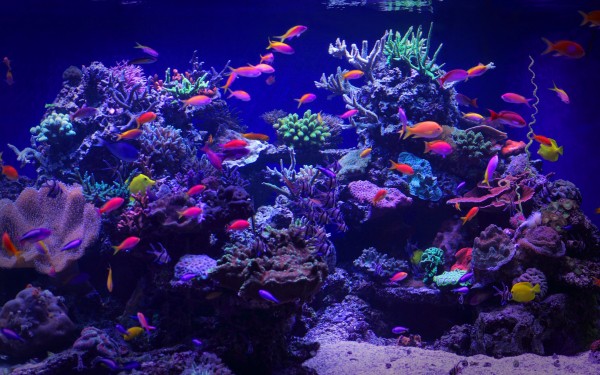
Aquatic Design and Landscaping: Creating a Miniature Ecosystem
The art and science of creating a miniature ecosystem within an aquarium is a captivating blend of aesthetic beauty and the essential requirements for a healthy habitat for aquatic life. This article sets out to delve into this unique form of artistic expression, discussing the principles of aquarium design and aquascaping, comparing the design aesthetics of freshwater and saltwater tanks, and offering tips for crafting visually appealing yet healthy habitats for aquatic life.
At the heart of aquarium design lie fundamental principles such as balance, focus, and harmony. These principles are crucial in creating an environment that is not only visually pleasing but also functionally effective for its inhabitants. The article introduces the concept of aquascaping, which involves creating naturalistic underwater landscapes that are both aesthetically pleasing and suited to the needs of the tank’s inhabitants. Various aquascaping styles, including Nature Style, Iwagumi, Dutch Style, and others, are discussed to illustrate how each style creates its own unique aesthetic and environmental niche within an aquarium.
The article then delves into the differing design aesthetics between freshwater and saltwater aquariums. It explores how the selection of fish, plants, corals, and decorations can significantly impact the overall ambiance of a tank. For freshwater aquascapes, typical features such as the use of driftwood, rocks, and a diverse array of plants are highlighted. In contrast, the unique aspects of saltwater design are discussed, with a focus on the integration of live rock, corals, and the vibrant colors of marine fish and invertebrates, which altogether create a distinct marine ambiance.
To design an aquarium that is both visually stunning and healthy for its inhabitants, the article provides practical tips. It covers important aspects like lighting, filtration, and the strategic placement of elements to achieve both aesthetic and functional benefits. Guidance is provided on selecting compatible species and plants that visually complement each other and coexist harmoniously. The importance of regular maintenance tasks, such as pruning plants, cleaning the tank, and monitoring water parameters, is emphasized to maintain the aquarium’s beauty and the health of its inhabitants.
In conclusion, the article reiterates the joy and satisfaction that comes from designing a miniature ecosystem. It encourages readers to express their creativity in aquatic design while being conscientious of the biological needs of their aquatic pets. Readers are invited to explore the world of aquatic design and landscaping, with the assurance that with the right knowledge and tools, they can create a stunning and thriving aquatic environment in their own homes. This endeavor is presented not just as a hobby but as a fulfilling journey that combines art, science, and a deep appreciation for the natural world.
Challenges and Rewards: Maintaining Your Underwater Kingdom
The intricate world of aquarium keeping is a journey marked by both challenges and immense rewards, requiring a deep sense of commitment and responsibility. This article aims to illuminate the dual nature of maintaining an underwater ecosystem, exploring the common challenges faced in both freshwater and saltwater aquariums, discussing health and wellness strategies for aquatic life, and highlighting the rewarding aspects of this fascinating hobby.
Aquarium hobbyists often encounter a variety of challenges, which differ significantly between freshwater and saltwater environments. In freshwater aquariums, issues such as controlling algae growth, managing fluctuating water parameters, and ensuring compatibility among different fish species are common. These challenges require careful attention and consistent management to maintain a healthy ecosystem. On the other hand, saltwater aquariums present their own set of difficulties, including maintaining stable salinity levels, the complexities involved in managing a reef tank, and the higher costs associated with advanced equipment and the care of delicate marine species. The article delves into these challenges, providing insights and solutions to help hobbyists navigate these hurdles.
A crucial aspect of aquarium keeping is ensuring the health and wellness of the aquatic inhabitants. This section of the article emphasizes the importance of preventive measures such as maintaining good hygiene, proper feeding practices, and regular water testing to prevent disease outbreaks. It explains common diseases that affect aquatic life in both freshwater and saltwater tanks, their symptoms, and methods of prevention and treatment. The article stresses the importance of early detection and intervention and encourages continuous learning about the specific needs and behaviors of different species to ensure their well-being.
Despite the challenges, the world of aquarium keeping is immensely rewarding. This part of the article shifts focus to the positive aspects, discussing the sense of accomplishment that comes with creating and nurturing a thriving ecosystem. It highlights the aesthetic pleasure, the calming effect, and the educational value of keeping an aquarium. The article shares insights from experienced aquarists about the deep connection and satisfaction derived from their hobby, whether it be through breeding fish, growing corals, or achieving aquascaping milestones.
In conclusion, the article reaffirms the balance of challenges and rewards in aquarium keeping, encouraging readers to embrace both aspects as integral parts of this rewarding journey. It inspires both potential and current aquarium hobbyists to continue learning and growing in their hobby. The article emphasizes that the rewards of creating and maintaining an underwater kingdom far outweigh the challenges, offering a fulfilling and enriching experience for those who are passionate about the aquatic world.
Environmental and Ethical Considerations in Aquarium Keeping
Aquarium keeping is more than just a hobby; it intersects profoundly with environmental and ethical considerations. This article starts with a thought-provoking introduction that emphasizes the importance of being a responsible aquarist, mindful of the broader ecological and ethical implications of their hobby. The objectives set for this article include examining the impact of the aquarium trade on natural habitats, advocating for sustainable and ethical practices in fishkeeping, and underscoring the role of education and conservation in this context.
The aquarium trade has significant effects on natural aquatic ecosystems. This section of the article discusses the negative impacts, such as overharvesting of popular fish species and the collection of wild corals, leading to habitat degradation and species depletion. Another critical issue is the introduction of invasive species through aquarium releases, which can disrupt local ecosystems. The article will provide statistics and real-world case studies to illustrate these impacts, offering a stark view of the consequences of unsustainable practices in the aquarium trade.
In response to these challenges, the article outlines sustainable practices in the aquarium hobby. This includes choosing captive-bred fish over wild-caught species and supporting breeders and suppliers who adhere to responsible practices. The ethical considerations in fishkeeping are also discussed, focusing on the need to provide adequate space, proper diet, and appropriate environmental conditions for each species. Emphasizing the importance of thorough research and understanding of the specific needs of each species, the article guides readers towards ensuring the well-being of their aquatic pets in a home aquarium.
Education plays a pivotal role in promoting responsible aquarium keeping. Informed hobbyists are better equipped to make choices that support conservation efforts. The article showcases how the aquarium community contributes to conservation, including breeding endangered species in captivity, participating in coral reef restoration projects, and leading public awareness campaigns. Readers are encouraged to get involved in local and global conservation efforts, emphasizing how collective actions can have a significant positive impact.
The conclusion reiterates the critical role that ethical and sustainable practices play in the aquarium hobby. It encourages readers to stay informed and actively engaged in conversations about environmental and ethical responsibilities in fishkeeping. The article aims to inspire readers to become ambassadors for responsible fishkeeping, highlighting that their choices and actions can contribute significantly to the preservation of aquatic ecosystems for future generations. By doing so, the article not only educates but also empowers readers to make a positive difference in the world of aquarium keeping.
Pros and Cons – Freshwater Vs Saltwater Tanks
Freshwater Fish Tanks
Pros:
- Easier Maintenance: Freshwater tanks generally require less stringent water quality control than saltwater tanks.
- Cost-Effective: The equipment and fish for freshwater tanks are usually more affordable.
- Wide Variety of Fish: There’s a vast range of freshwater fish available, suitable for all levels of experience.
- Easier Setup: Setting up a freshwater tank is typically simpler, making it ideal for beginners.
- Lower Operating Costs: Freshwater tanks often have lower ongoing costs related to energy and maintenance.
Cons:
- Limited to Freshwater Species: You’re restricted to freshwater species, which might be a downside if you’re interested in exotic marine life.
- Less Colorful Fish: While there are colorful freshwater fish, they often don’t match the vibrancy of marine species.
- Simpler Ecosystems: Freshwater tanks might not offer the complexity and diversity of coral reef environments found in saltwater tanks.
Saltwater Fish Tanks
Pros:
- Vibrant Marine Life: Saltwater tanks can house a diverse array of bright and exotic fish and coral species.
- Complex Ecosystems: They offer the opportunity to create intricate and fascinating marine ecosystems.
- Challenging and Rewarding: The complexity of maintaining a saltwater tank can be a rewarding hobby for experienced aquarists.
- Educational Value: They provide an excellent way to learn about marine biology and environmental conservation.
Cons:
- More Expensive: Both the initial setup and ongoing maintenance costs are higher for saltwater tanks.
- Complex Maintenance: Requires careful monitoring and control of water parameters, which can be challenging for beginners.
- Sensitive Inhabitants: Marine species often have specific and demanding habitat requirements.
- Higher Risk: Saltwater tanks are less forgiving of mistakes, and fluctuations in water quality can have severe consequences.
Conclusion
As we conclude this series, we take a moment to reflect on the enchanting beauty of underwater realms, a world that aquarium enthusiasts have the privilege of experiencing up close. Throughout this journey, we have explored the diverse landscapes of freshwater and saltwater tanks, delved into the intricacies of aquatic design, and balanced the joy of fishkeeping with its inherent responsibilities. This final piece aims to encapsulate the essence of these themes, offering a reflective overview of the mesmerizing world of aquariums.
Aquarium keeping offers multifaceted joys – from the tranquility and aesthetic beauty it adds to our spaces, to the fascination of observing aquatic life flourish, and the creative fulfillment derived from aquascaping. However, these pleasures come with significant responsibilities. We reiterate the importance of ethical practices, environmental awareness, and a commitment to the health and well-being of aquatic life. It’s a hobby that demands not just time and resources but also a profound respect for nature and its delicate ecosystems.
For beginners, the world of aquarium keeping might seem daunting, but with research, patience, and dedication, it’s a journey that is immensely rewarding. We offer words of encouragement to these new enthusiasts, assuring them of the wonders that await. For the experienced aquarists, we suggest avenues for further exploration and growth, such as trying new aquascaping styles, breeding rare species, or engaging in conservation efforts. The importance of community in this hobby cannot be overstated, and we encourage readers to connect with fellow enthusiasts for support, advice, and shared experiences.
Reflecting on the unique allure of both freshwater and saltwater aquariums, we recognize that each offers its own set of challenges and rewards. Whether it’s the diverse ecosystems of freshwater tanks or the vibrant marine life in saltwater aquariums, each presents a world of beauty and complexity to be appreciated and respected.
In conclusion, this series invites readers to view aquarium keeping not just as a pastime but as a journey of discovery, responsibility, and continuous learning. It’s a path that leads to a deeper understanding of the natural world, fostering a connection with the enigmatic and wondrous life beneath the water’s surface. We encourage readers to embrace this journey, exploring the enthralling beauty of underwater realms with curiosity, care, and a sense of stewardship.


